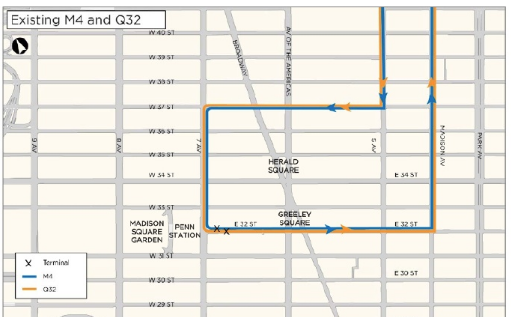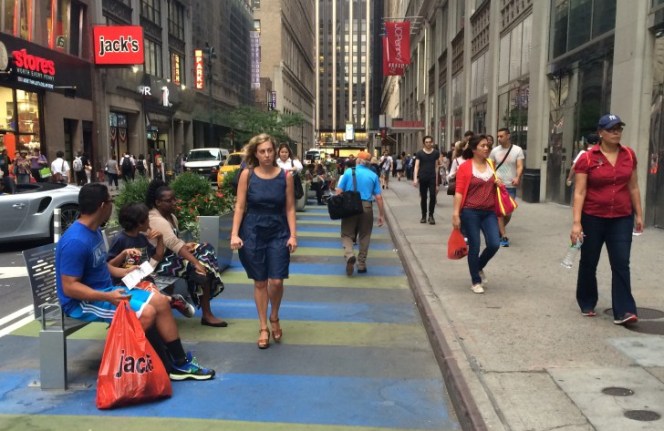For one glorious summer in 2015, the block of 32nd Street between Penn Station and Greeley Square had a wide, generous sidewalk. It was a huge relief for the throngs of people walking to the nation's busiest rail hub. But it didn't last.
Now there's a plan to bring the 32nd Street supersidewalk back, and the final sticking point involves MTA bus stops that will have to be relocated. Advocates are calling on the MTA to let the change move forward by rerouting the M4 and Q32 buses.
On the block of 32nd Street between Sixth and Seventh avenues pedestrians outnumber vehicles 22 to 1. DOT and real estate giant Vornado implemented the painted sidewalk expansion to give people on foot some breathing room, but the redesign was nixed after a short trial. Vornado attributed the decision to complaints about the loss of commercial loading zones on the block.
It's hard to keep a good idea down, though, and last year, Vornado proposed bringing the sidewalk expansion back. To make room for commercial deliveries, the Q32 and M4 stops on the block would need to be relocated. While this would increase the distance bus riders have to walk to access Penn, the buses already don't travel much faster than walking on these crosstown streets.
Because shifting the bus stops stands to improve the reliability of both routes while making pedestrian access to Penn Station better for everyone, the executive directors of the Tri-State Transportation Campaign, Transportation Alternatives, the Municipal Art Society, and the Regional Plan Association called the plan a "win-win" for pedestrians and bus riders in a March 2 letter to MTA New York City Transit President Andy Byford [PDF].
"Improving the pedestrian experience on 32nd Street between 6th Avenue and 7th Avenue, starting at the busiest entrance and exit to Penn Station, is an opportunity to both improve mass transit and make our streets safer," the letter says.

The Q32 and M4 both have F ratings from the Bus Turnaround Campaign due to slow speeds and poor on-time performance. That's led to ridership declines of more than 15 percent between 2010 and 2014.
The amount of time both routes spend stuck in crosstown traffic between Madison and Seventh avenues simply isn't worth it for commuters. On the M4, fewer than 14 percent of riders travel on the affected segment. On the Q32, that number is less than 3 percent. Those numbers have dropped precipitously -- by over 50 percent -- in recent years.
MTA reps floated their version of the Vornado proposal to affected community boards, including those served by the route in Queens, but the agency has yet to move forward. In a statement, the MTA was non-committal about shifting the bus stops to improve pedestrian access to Penn:
While NYC Transit fully appreciates the need to improve the safety and viability of pedestrian spaces, it is also important to maintain a multi-modal connection between fully accessible bus routes and Penn Station, a significant regional transportation hub which is served by the Long Island Rail Road, Amtrak and New Jersey Transit. We are continuing to work with NYC DOT on this issue.






